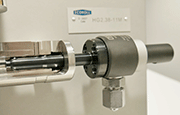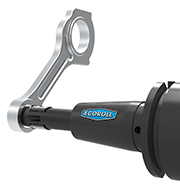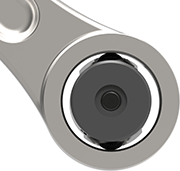E-Archive
Interview
in Vol. 18 - May Issue - Year 2017
Innovative Tools And Processes For Metal Surface Improvement

Markus Diedrich-Philippi, Head of Sales of ECOROLL AG Werkzeugtechnik

Effects due to Deep Rolling

Tool HG2.38-11M for processing connecting rods and piston pins

Tool HG2.38-11 for processing bore holes up to 3 mm

Tool HG2.38-11M for processing connecting rods and piston pins processing area

Tool HG2.38-11M for processing connecting rods and piston pins Schematic representation

Tool HG2.38-11M


Tool HG6-11M processing connecting rod
MFN approached Mr. Markus Diedrich-Philippi, Head of Sales of ECOROLL AG Werkzeugtechnik, as the leading manufacturer of tools for Roller Burnishing, Deep Rolling and Skive-Burnishing, to talk about the latest process and tool developments and the advantages of these methods.
(?) MFN: Mr. Diedrich-Philippi, please describe the difference between Roller Burnishing and Deep Rolling for our readers.
(!) M. D. P.: Roller Burnishing and Deep Rolling are related processes. In both processes, boundary layers of a work piece are plastified and formed by a rolling element, which can be a ball as well as a roller. The main difference is goal setting. The goal of Roller Burnishing is to achieve a specific surface quality in the form of a pre-defined roughness value, while Deep Rolling focuses on increasing the operational stability of the machined part. Although the increase of the component lifetime is based on Roller Burnishing, the induction of residual stresses and cold strengthening has a more significant influence.
(?) MFN: What are the advantages of Deep Rolling and what processes can be replaced by this one?
(!) M. D. P.: Critical is the Deep Rolling of irregular, non-rotationally symmetric components, for example coil springs. In this case, shot peening is the advantageous treatment since Deep Rolling tools won´t get access to these complex contours. Besides that, Deep Rolling has a wide number of advantages compared to shot peening. So, the most important fact is the reliability of the process since in most applications, the treatment takes place on a machine tool where a high accuracy and a constant repeatability is obvious. Furthermore, the number of influencing process parameters is quite low. Except for the constant tool geometry, it is only necessary to control the correct Deep Rolling force and machining parameters like speed and feed rates. Another important aspect is high profitability of Deep Rolling. The process is made directly after the pre-machining process of a component, when it is still in the same clamping, e. g. on a lathe. The investment costs for Deep Rolling tools are comparably low and the process time is very short. Since Deep Rolling will be processed in house, external treatments or an investment for shot peening machinery are unnecessary.
Deep Rolling is the only mechanical rim zone strain hardening process that results in smoothing the surface, the induction of compressive residual stresses, and cold work hardening. It provides benefits like significant increase of the lifetime of a component, integrates seamlessly into the process chain, enables process monitoring, and enables greater and deeper residual stresses than does shot peening.
All mechanical (e.g. shot peening), thermal (e.g. laser hardening) and thermochemical (e.g. nitriding) processes for increasing fatigue strength of a component can be replaced by Deep Rolling. Since any case of application implies new challenges and questions, an individual assessment is necessary in order to meet your special requirements.
(?) MFN: And in which application areas can Roller Burnishing and Deep Rolling be used?
(!) M. D. P.: The possibilities are huge. Everywhere where components are exposed to alternating load duty cycles, we will find fatigue and therefore applications for Deep Rolling. It could be the 1 mm titanium wire of a medical application or a 3 x 9 m large rotor shaft of a steam turbine where ECOROLL tools are dependable to fulfill their tasks. Today, we have applications in the automotive industry, on passenger cars and trucks, for components of combustion engines, steering parts, axle components, disc brakes etc. Other fields are mechanical engineering in general, railway vehicles, shipbuilding, aerospace, oil & gas, conventional energy, renewable energy and medical implants.
This is just a rough consideration; I’m sure there will be more.
Roller Burnishing is applied if metal components with high or pre-defined surface quality are requested, or the desired quality cannot be achieved in a reliable manner by machining. When the need is for increasing the operational stability of a metal material or realizing solutions for lightweight-construction, Deep Rolling is applicable.
(?) MFN: Finally, there is only one more question. Our readers would like to know, what are the latest developments in the areas of Roller Burnishing, Deep Rolling and Skive-Burnishing?
(!) M. D. P.: Tools and processes for the small ends of connecting rods and piston pins are some of our latest developments where cost-effective production of optimized surfaces for increasing service life is the goal.
The tool systems and related technologies by ECOROLL AG offer new and alternative methods with regard to the small ends of connecting rods and piston pins. Roller Burnishing and Deep Rolling tools are used to produce surfaces with the respective functionality and specifically conditioned material properties in the near surface layer zone. Not only are the characteristics improved and the process chain simplified and shortened, but less expensive materials can also be used and service life improved significantly. This is all reflected in cost-effectiveness. Especially, optimization in the area of the small ends of connecting rods plays an important role here. This includes the production of connecting rods without bushings, pressing bushings into connecting rods and machining piston pins.
Furthermore, we are developing a possibility to use our Deep Rolling tools for smaller diameters. We created a tool that allows us to use this process up to a diameter of 3 mm. Therefore, we were able to extend the service intervals for central valves for one of our customers from 15 hours up to 800 hours after he implemented our new Deep Rolling process.
MFN would like to thank Markus Diedrich-Philippi for this interview!
For Information:
Ecoroll AG Werkzeugtechnik
Hans-Heinrich-Warnke-Straße 8
29227 Celle, Germany
Tel. +49.5141.9865 0
Fax +49.5141.881 440
E-mail: mail@ecoroll.de
www.ecoroll.de



























